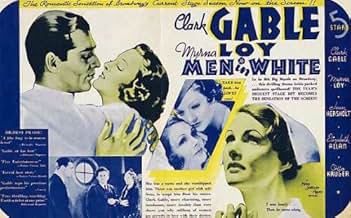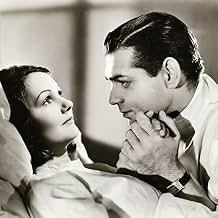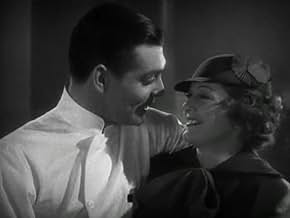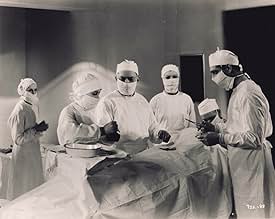PUNTUACIÓN EN IMDb
6,3/10
812
TU PUNTUACIÓN
Añade un argumento en tu idiomaAn idealistic doctor must make some hard choices between his dedication to the profession and his personal life.An idealistic doctor must make some hard choices between his dedication to the profession and his personal life.An idealistic doctor must make some hard choices between his dedication to the profession and his personal life.
- Dirección
- Guión
- Reparto principal
- Premios
- 2 premios en total
Harry C. Bradley
- Minister
- (sin acreditar)
Frank Burke
- Interne
- (sin acreditar)
Ruth Channing
- Nurse
- (sin acreditar)
Berton Churchill
- John Hudson
- (sin acreditar)
Reseñas destacadas
this is one of the few gable movies that i like. i was surprised by gable's acting, it was so unlike his macho man roles. his humanity came out in this performance. loy was a little irritating to me, which is rare, i so love her movies with William Powell. she seemed like a spoiled rich girl, unaware and uncaring of the plights of the sick and ailing, so unlike her Nora Charles rich girl. in it's own way it is a forerunner of er, not quite so fast-paced, but intense all the same. i was a little confused about the ailing nurse, it wasn't clear to me whether she had an abortion or if she had tried to commit suicide. perhaps some parts had been cut out that better explained it, although i watched it on tcm, they usually show movies in their entirety. i did have to chuckle at loy's serious line about "humanity", and her look away. it seemed a little overdone. a very good movie, ahead of it's time.
"Men in White" is a 1934 film starring Clark Gable, Myrna Loy, Jean Hersholt, Elizabeth Allan, and Otto Kruger. Gable plays a promising young doctor, George Ferguson, who is planning on studying in Vienna and then returning and working closely with Dr. Hochberg (Hersholt), apparently in scientific research. He's engaged to a society woman, Laura Hudson (Loy) who is already upset about the lack of time she and George have together. She would rather he go into private practice and work regular hours. This becomes a subject of argument, and the situation goes from bad to worse, particularly one night when an angry Laura stops speaking to George.
This film is based on a Pulitzer Prize winning play by Sidney Kingsley, which, in addition to what is shown in the film, also dealt with anti-Semitism. The idea of going to Vienna in 1934, with the Loy character rhapsodizing over it - guess MGM was out of touch with what was happening, or chose to ignore it.
The acting in this film is very good, if by today's standards, a little melodramatic in parts. Otto Kruger has a very sympathetic role in this - later on he always played someone truly nasty.
The real star of the film is the absolutely incredible art deco hospital set that has to be seen - stunning, with a circular staircase, and huge windows that overlook the George Washington Bridge. The photography is marvelous, particularly an operating room scene where we see doctors observing in a top area reflected through a light.
The other things you'll notice, if you've been alive more than a few years, are the nurses' uniforms and caps and the glass straws, items we don't see any longer. And a little girl's parents who would be cast as her great-grandparents today.
The story isn't spelled out for us - in fact, I can tell you my mother, as an adult, could have sat through it and had no idea what happened. Talk about subtle.
Definitely worth seeing, with Gable and Loy an effective team.
This film is based on a Pulitzer Prize winning play by Sidney Kingsley, which, in addition to what is shown in the film, also dealt with anti-Semitism. The idea of going to Vienna in 1934, with the Loy character rhapsodizing over it - guess MGM was out of touch with what was happening, or chose to ignore it.
The acting in this film is very good, if by today's standards, a little melodramatic in parts. Otto Kruger has a very sympathetic role in this - later on he always played someone truly nasty.
The real star of the film is the absolutely incredible art deco hospital set that has to be seen - stunning, with a circular staircase, and huge windows that overlook the George Washington Bridge. The photography is marvelous, particularly an operating room scene where we see doctors observing in a top area reflected through a light.
The other things you'll notice, if you've been alive more than a few years, are the nurses' uniforms and caps and the glass straws, items we don't see any longer. And a little girl's parents who would be cast as her great-grandparents today.
The story isn't spelled out for us - in fact, I can tell you my mother, as an adult, could have sat through it and had no idea what happened. Talk about subtle.
Definitely worth seeing, with Gable and Loy an effective team.
This movie is best known in film history as the inspiration for the Three Stooges' comedy short "Men in Black", although there is really no comparison between the two. This is a well-paced little hospital drama made right before the production code began to be enforced. Dr. George Forrest (Clark Gable) is an intern at a busy hospital and Laura Hudson (Myrna Loy) is his socialite fiancée. Forrest wants to study under Dr. Hochberg (Jean Hersholt) when his time is up as an intern, but it means only twenty dollars a week and long indefinite hours. Laura wants her fiancée to go into private practice so that they can have a normal life together after their marriage. Laura may be a bit of a spoiled brat, but she knows it, so it makes her more likable. Forrest is torn between wanting to please Laura and wanting the great chance to work with Hochberg. A fight between the couple one night sets up the scene for a scandal that has the opportunity to derail both Forrest's career and personal life. That is pretty much the crux of the movie.
What keeps it interesting is the pacing and the performances. I found it to be the most believable of the Gable/Loy pairings I've seen. Plus, unlike so many MGM dramas of the 30's, there is no unreasonable bad guy in sight - only the fight to advance medicine. Another matter of interest is the art deco interior design of the hospital. For example, there is a staircase in the main lobby of the hospital that is out of this world.
What keeps it interesting is the pacing and the performances. I found it to be the most believable of the Gable/Loy pairings I've seen. Plus, unlike so many MGM dramas of the 30's, there is no unreasonable bad guy in sight - only the fight to advance medicine. Another matter of interest is the art deco interior design of the hospital. For example, there is a staircase in the main lobby of the hospital that is out of this world.
CLARK GABLE is a dedicated doctor conflicted by feelings involving the workplace and romance--almost the forerunner of the character ROBERT MITCHUM would play twenty years later (Luke) in NOT AS A STRANGER. The film deals with medicine much the way Stanley Kramer's film did, but it's based on a stage play and the static quality owes something to that and the lack of background music on the soundtrack.
Of course it's all very dated--a giveaway is interns supposedly making $20 a week!! MYRNA LOY is a selfish, wealthy young woman who wishes Gable would give her his undivided attention instead of dedicating himself to work. Gable has to assert himself at the hospital when an older physician overrules his instructions on insulin and puts a patient into shock. Gable's character here is reminiscent of Lucas Marsh in Morton Thompson's best-seller NOT AS A STRANGER as he pulls the syringe from the doctor's hand and takes charge of the procedure.
There are weak moments of comedy relief, mostly from WALLACE FORD, and a maudlin performance from OTTO KRUGER that is painfully overplayed. The dialog too, tends to be preachy about the medical profession.
Self-doubting and lonely, Gable shares some romantic scenes with pretty nurse ELIZABETH ALLAN who confides in him about her own uneasy feelings as a nurse dealing daily with life and death situations. The love scene is handled with such discretion it's hard to determine the plot developments that come swiftly afterwards, but after Allan's tragic death Gable resumes his romance with Loy, who realizes his work will always come first in his life.
Nothing deep here, just a routine medical drama with all of its stage bound ingredients intact. Music is only used once for a restaurant scene where violins are playing a Viennese waltz, which leaves a lot of the drama feeling flat and one-dimensional.
JEAN HERSHOLT has his usual role of an avuncular medical man under whom Gable intends to study abroad, but the focal point is the Gable/Loy/Allan romantic triangle.
Summing up: From any standpoint, a trifle in Gable's career and notable only in that he plays a more sensitive role than usual.
Of course it's all very dated--a giveaway is interns supposedly making $20 a week!! MYRNA LOY is a selfish, wealthy young woman who wishes Gable would give her his undivided attention instead of dedicating himself to work. Gable has to assert himself at the hospital when an older physician overrules his instructions on insulin and puts a patient into shock. Gable's character here is reminiscent of Lucas Marsh in Morton Thompson's best-seller NOT AS A STRANGER as he pulls the syringe from the doctor's hand and takes charge of the procedure.
There are weak moments of comedy relief, mostly from WALLACE FORD, and a maudlin performance from OTTO KRUGER that is painfully overplayed. The dialog too, tends to be preachy about the medical profession.
Self-doubting and lonely, Gable shares some romantic scenes with pretty nurse ELIZABETH ALLAN who confides in him about her own uneasy feelings as a nurse dealing daily with life and death situations. The love scene is handled with such discretion it's hard to determine the plot developments that come swiftly afterwards, but after Allan's tragic death Gable resumes his romance with Loy, who realizes his work will always come first in his life.
Nothing deep here, just a routine medical drama with all of its stage bound ingredients intact. Music is only used once for a restaurant scene where violins are playing a Viennese waltz, which leaves a lot of the drama feeling flat and one-dimensional.
JEAN HERSHOLT has his usual role of an avuncular medical man under whom Gable intends to study abroad, but the focal point is the Gable/Loy/Allan romantic triangle.
Summing up: From any standpoint, a trifle in Gable's career and notable only in that he plays a more sensitive role than usual.
This is one darn good movie. Clark Gable (pre-GWTW) gives a super performance, and Myrna Loy never looked lovelier (and puts in a good performance herself). The story is compelling without being maudlin, and the comic relief doesn't get in the way (as it usually does). Hospital chaos is well depicted, and not everything turns out rosey. We of our era didn't invent "realistic" hospital drama -- we just think we did. Dated? Of course it's dated -- it was made over 60 years ago. However, sixty years from now, they'll be laughing at the stuff we're putting on TV, but they'll still be riveted to "Men in White."
¿Sabías que...?
- CuriosidadesBecause of the suggested illicit romance and the suggested abortion in the movie, it was frequently cut. The Legion of Decency cited the movie as unfit for public exhibition.
- PifiasNear the end of the film, Dr. Ferguson picks up the telephone before the paging operator even finishes saying his name.
- ConexionesFeatured in Mujeres liberadas (2003)
Selecciones populares
Inicia sesión para calificar y añadir a tu lista para recibir recomendaciones personalizadas
Detalles
Taquilla
- Presupuesto
- 213.000 US$ (estimación)
- Duración1 hora 14 minutos
- Color
- Relación de aspecto
- 1.37 : 1
Contribuir a esta página
Sugerir un cambio o añadir el contenido que falta





































